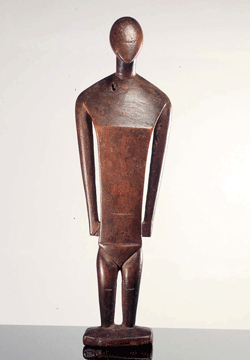Can’t get away this summer because of the financial crisis? Well, for New Yorkers and their visitors, a small but superlative show of African and Oceanic art at the Metropolitan Museum of Art, which runs until Sept. 27, can take you continents away.
You will owe this transport of your imagination to a young man named Josef Mueller, son of a wealthy Swiss industrialist, who journeyed to Paris in 1907 at the age of 20, discovered Cézanne, Picasso and other Modernists and began to collect not only their work but the non-Western art that many of them were discovering. (It was the year of Picasso’s “Les Demoiselles d’Avignon.”) When Mueller’s daughter Monique married another collector, Jean Paul Barbier, in 1955, the couple set to building the collection together and, on her father’s death in 1977, formally opened the Barbier-Mueller Museum in Geneva. A stunning selection of its holdings has now been lent to the Met.
Every piece in the show is of the highest quality—21 from western and central Africa and 16 from the great expanse of Pacific islands collectively known as Oceania. They are also presented in two gallery spaces at the center of the Michael D. Rockefeller, Jr. Wing, handsomely re-installed by the Met in 2007. (The Rockefeller galleries go back to Nelson Rockefeller’s 1957 Museum of Primitive Art.) As a result, for anyone who doesn’t yet know this regional art, the Barbier-Mueller show is a nonpareil introduction. But if you have already begun to appreciate it, a good many pieces from Geneva will send you off with fresh eyes to consider comparable examples in the Rockefeller galleries.
Opening the exhibition are two fantastic wood carvings, a “Serpent Headdress” from the Boke district of Guinée (20th century) and a figure known as a Bioma from Papua New Guinea (19th century). Combining human and animal features, the headdress is a tall, sinuous piece with geometric patterning and studs of glass. It was placed atop a masquerade ensemble to evoke a mystical serpent known as Nininanka and was used as a sign of a clan’s identity at the initiation of boys and girls into adulthood. (Nearby, in the Met’s collection, are two similar pieces and an example of a full masquerade dress.) The Papuan sculpture, a flat anthropomorphic figure with a marvelous mixture of curving lines and geometric design, was used with offerings to powerful spirits known as imunu who were central to the Papuans’ art and religion.
When this work is painted, the palette runs typically to white, black and a deep orange, as in a 19th century mask—belonging to a cultural genre known as kidumu, from the Teke peoples of the Republic of Congo—which served both as a record of the peoples’ identity and as an instrument of divination during ritual performances. (It once belonged to the French artist André Derain.) But many of the larger pieces are mostly unpainted wood, as in the 19th century, superbly preserved, almost life-size female figure created by an artist of the Senufo people in Côte d’Ivoire. One of a pair, it symbolized the origins of humanity and the foundations of society and was used by key initiation societies known as poro. The Barbier-Mueller’s example has a typically gazelle-like head, large protuberant breasts on a slim torso and long slender arms that grow in size as they reach hands that rest confidently on her thighs. By comparison, the Rockefeller Wing’s nearby male example, much less well preserved, seems like a mere boy rather than a protector and guarantor of social continuity.
Likewise unforgettable is a “power figure” from the Democratic Republic of the Congo (18th-19th century). Studded with nails and other strips of metal that document vows, treaties and efforts to eradicate evil, this menacing presence has an abdominal cavity for medicinal material and holds a spear in his upraised right arm. As with the Met’s own example, a perhaps even more threatening piece that currently presides at the entrance to the Rockefeller Wing, the injunction to observe social convention is ferociously palpable.
Many smaller pieces enchant as well. Perhaps the most beautiful—or is this a Western prejudice?—is the early (12th -14th century) terra cotta head of a young woman wearing a small round cap over her stylized hair and an elaborate ornament over her right ear. She comes from Nigeria, from a civilization that developed around the ancient Yoruba city-state of Ife and exquisitely embodies the Yoruba account of the divine creator’s giving shape to humanity from modeled clay. Her perfect lines and proportions will re-occur in the masks of the Baule peoples in 19th century Côte d’Ivoire as well as in the idealized sculptural representations of wild and threatening spirits from the ancestral world that Baule diviners commissioned in hopes of appeasing them. (The sense for diplomacy is dazzling.)
Oceania refers to the more than 25,000 islands of the Pacific which cover over a third of the earth’s surface. Home to at least 1,800 different cultures and hundreds of artistic traditions, the area can be given a single name only in the most general sense, as is also of course the case with “Africa.” Certain features of the region’s art, however, echo Africa’s: the interlocking of daily life and religious beliefs; the communal and often performance-oriented character of the art; its focus on key stages of life (birth, maturity, death and burial); its sexual candor; and the use of ordinary materials (wood, grasses, hides) mixed at times with precious textiles (copper, beads, turtle-shell).
Many of these features are evident in a 19th century stone equestrian figure of a chief from the Batak people of Sumatra. The three-foot-high sculpture is a strong, sharply carved portrait of the chief (possibly also a priest) riding a singa, a supernatural creature with the body of a horse, hindquarters like a dog’s and a snake-like tongue that curls back beneath its muzzle with eerie, discomforting effect. As a funerary monument, the piece vividly conveys both the vigor of its subject’s life and the spirit-world that surrounded it.
Also on view is a wonderful selection of 19th-century masks from the North Solomon Islands, Southern New Ireland, Papua New Guinea and the Torres Strait Islands. Children will love them, but you might want to take a young child’s hand in front of the “Helmet Mask from North New Ireland,” which is as terrifying as it is gorgeous. Used in ceremonies at the final memorial for a prominent member of the clan, it has a face made of beeswax over a wooden core, wide slit-eyes, a strong, eagle-like nose and high vertical panels above the ears through which two snakes weave in and out up to the top—with equally chilling and mesmerizing effect.
As timelessly serene as the New Ireland mask is fiercely present, a female figure (Dinonga Eidu) from Nukuoro Island in Micronesia is another show-stopper. An 18th- or 19th-century sister to one of the Met’s early Cycladic figures (c. 2700-2600 BC) and about the same size (just short of 16 inches), the piece mixes soft curves and rigid angles in a severely abstract rendering of the female form. The type came in two sizes, with the larger versions—some over seven feet high—kept in a ceremonial house and smaller ones in clan shrines or family dwellings. The Nukuorans venerated both deities and deified ancestors, each manifest in such objects, and the stylization of this female form will appear to a Western eye as a brilliant solution of its multiple levels of meaning.
It astonishes to recall that this art was once all called “primitive.” But then the Italians of the Trecento and Quattrocento were lovingly called “primitives,” too. In the early 20th century, as well, enormously successful exhibitions were devoted to the “Flemish Primitives” in 1902 in Bruges and to the “French Primitives” in Paris in 1904 (in both cases on grounds that were in part quite chauvinistic). The Met’s current show moves decisively beyond that perspective, rejecting the presumption that Western standards are the final arbiters of aesthetic achievement. Instead, it revels in the formal inventiveness and human expressivity of the art, while also discreetly offering sensitive interpretations of its context and social significance, both religious and secular. You may start out finding the material strange. But gradually you feel a common instinct for self-expression and social connectedness, not to mention the powerful sense of a higher, transcendent realm on which these cultures felt deeply dependent. Whole continents and worlds open up for us in these galleries—and we meet figures from afar who are at the same time as close to us as our own truest humanity.
“African and Oceanic Art from The Barbier-Mueller Museum, Geneva: A Legacy of Collecting” was organized by Alisa LaGamma and Eric Kjellgren, in collaboration with Yaël Biro, from the Metropolitan’s Department of the Arts of Africa, Oceania and the Americas, and will be on view through September 27. It is accompanied by the catalogue Arts of Africa and Oceania: Highlights from the Musée Barbier-Mueller.








